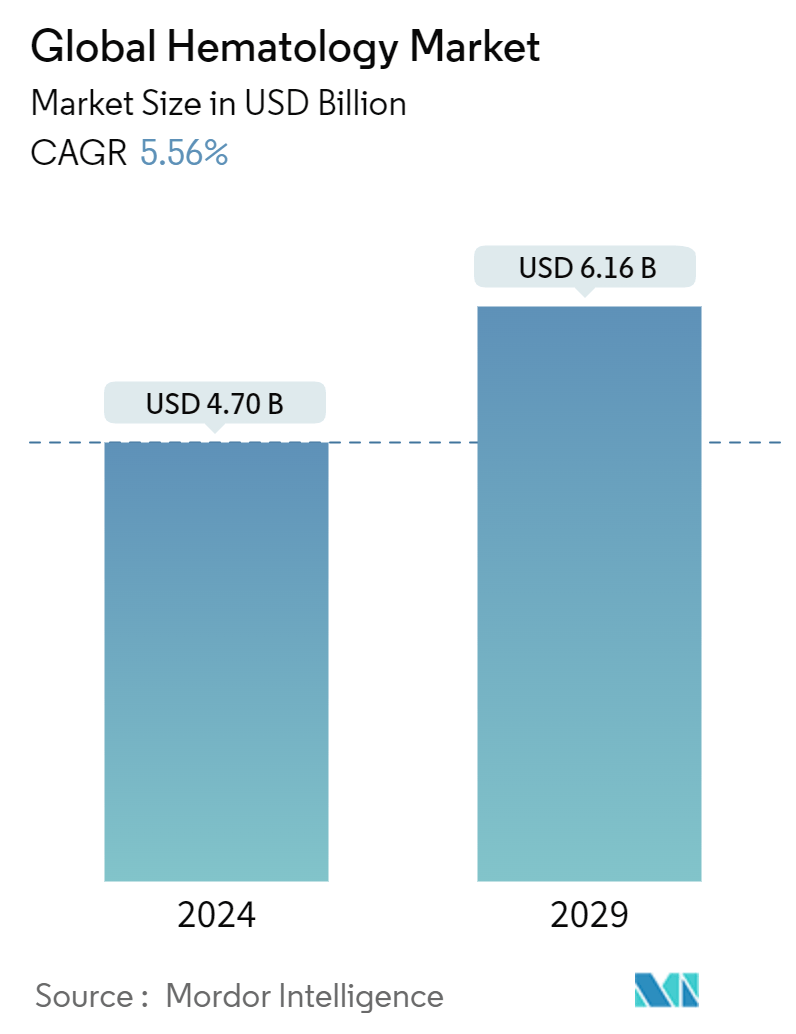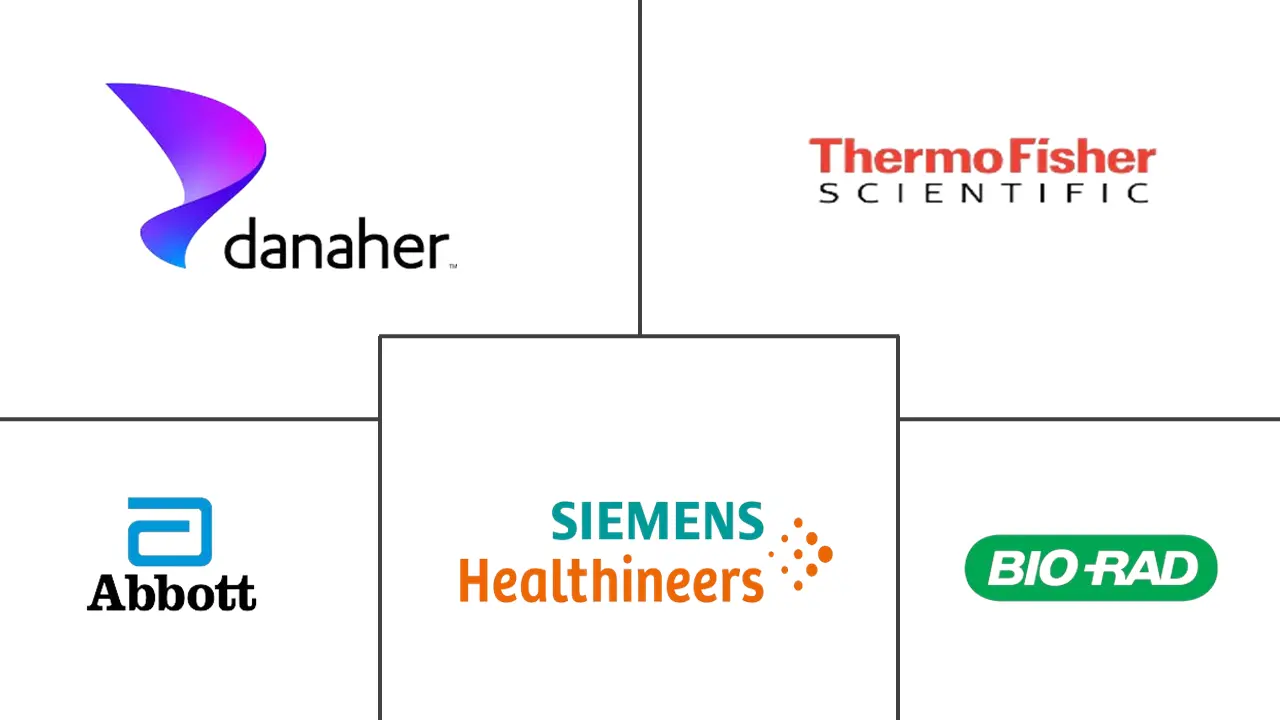Market Size of Global Hematology Industry

| Study Period | 2019 - 2029 |
| Market Size (2024) | USD 4.70 Billion |
| Market Size (2029) | USD 6.16 Billion |
| CAGR (2024 - 2029) | 5.56 % |
| Fastest Growing Market | Asia Pacific |
| Largest Market | North America |
Major Players
*Disclaimer: Major Players sorted in no particular order |
Global Hematology Market Analysis
The Global Hematology Market size is estimated at USD 4.70 billion in 2024, and is expected to reach USD 6.16 billion by 2029, growing at a CAGR of 5.56% during the forecast period (2024-2029).
The growth of the hematology market is attributed to the increasing burden of blood disorders and other related disorders, rapid technological advances in hematology, and the emergence of high throughput hematology analyzers. In addition, the increasing efforts to develop cutting-edge hematology platforms are expected to accelerate market uptake during the study period.
The increasing prevalence of blood and related disorders is anticipated to accelerate demand for various hematology products, such as analyzers, flow cytometers, and centrifuges, to detect potential abnormalities in blood. This trend is likely to shape industry uptake during the study period.
For instance, according to the 2024 updated data from the American Cancer Society, leukemia cases have ramped from 59,610 in 2023 to 59,610 in 2024. Similarly, per the same source, the number of myeloma cases has increased from 35,730 in 2023 to 35,780 in 2024. Hence, the high prevalence of blood cancer is estimated to drive the demand for hematology instruments and consumables, which, in turn, is expected to accelerate market expansion during the study period.
Similarly, the increasing burden of hemophilia and clotting conditions are further expected to spur demand for coagulation analyzers to monitor blood clotting properties. For instance, according to the 2024 updated data of the National Bleeding Disorders Foundation, around 12 in 100,000 people are affected with hemophilia in the United States and around 400 children are born with this condition every year. Such a high burden of hemophilia is anticipated to bolster demand for hematological products and consumables, which is expected to accelerate market growth over the coming years.
In addition, the growing adoption of high-throughput and automated hematology analyzers and several benefits associated with automated analyzers are expected to boost market expansion during the study period. Modern hematology analyzers are highly automated, offering increased throughput, reduced turnaround time, and improved accuracy, making them more efficient and cost-effective.
For instance, according to an article published by the Indian Journal of Hematology and Blood Transfusion in August 2023, advanced automated high-throughput analyzers allow the measurement of different hematological parameters in a more objective and precise manner compared to manual methods and have less turnaround time, which makes them more popular among end users. Thus, the growing adoption of high-throughput analyzers and the several benefits are projected to propel market growth forward over the coming years.
Also, prominent players' active participation in the market and ongoing technological advancements and product launches are further projected to spur market growth. For instance, in May 2023, Sysmex Corporation launched its Clinical Flow Cytometry System Flow Cytometer XF-1600 in Japan after its commercial success in Europe and North America. This launch helped the company to strengthen the diagnosis of hematological diseases such as leukemia and malignant lymphoma in Japan.
In addition, in June 2022, Thermo Fisher Scientific Inc. introduced the new EliA RNA Pol III and EliA Rib-P blood tests to diagnose systemic sclerosis and systemic lupus erythematosus (SLE), thus further expanding its comprehensive menu of automated connective tissue disease tests. Thus, such developments undertaken by prominent players are augmenting the market growth.
The factors mentioned above, such as the increasing prevalence of hematological disorders, the rising use of high-throughput systems, and various strategic initiatives carried out by market players, are anticipated to drive market growth in the coming years.
However, the high cost of instruments and the lack of skilled laboratory professionals are expected to hinder market expansion during the study period.
Global Hematology Industry Segmentation
As per the scope of the study, hematology is a branch of medicine that deals with blood and blood-related disorders. Hematology tests include various tests on the blood, blood proteins, and blood-producing organs to evaluate a variety of blood conditions, including infection, anemia, inflammation, hemophilia, blood-clotting disorders, leukemia, and the body’s response to chemotherapy treatments.
The hematology market is segmented by product, reagents, application, end user, and geography. Based on product, the market is segmented as hematology analyzers, flow cytometers, coagulation analyzers, slide stainers, centrifuges, hemoglobinometers, and other products. Based on reagents, the market is segmented into coagulation reagents, flow cytometry reagents, immuno-hematology reagents, and other reagents. Based on application, the market is segmented into drug testing, auto-immune diseases, cancer, diabetes mellitus, infectious diseases, and other applications. Based on end user, the market is segmented into hospitals, clinical testing institutes, patient self-testing, and other end users. By geography, the market is segmented into major regions like North America, Europe, Asia-Pacific, Middle East and Africa, and South America.
The report also covers the market sizes and forecasts for the hematology market in major countries across different regions. For each segment, the market size is provided in terms of value (USD).
| By Product | |
| Hematology Analyzers | |
| Flow Cytometers | |
| Coagulation Analyzers | |
| Slide Stainers | |
| Centrifuges | |
| Hemoglobinometers | |
| Other Products |
| By Reagent | |
| Coagulation Reagents | |
| Flow Cytometery Reagents | |
| Immuno-hematology Reagents | |
| Other Reagents |
| By Application | |
| Drug Testing | |
| Auto-immune Diseases | |
| Cancer | |
| Diabetes Mellitus | |
| Infectious Diseases | |
| Other Applications |
| By End User | |
| Hospitals | |
| Clinical Testing Institutes | |
| Patient Self-testing | |
| Other End Users |
| Geography | ||||||||
| ||||||||
| ||||||||
| ||||||||
| ||||||||
|
Global Hematology Market Size Summary
The hematology market is poised for significant growth, driven by the increasing prevalence of blood disorders and technological advancements in hematology analyzers. The market's expansion is further fueled by the rising demand for hematology tests, particularly in the context of the COVID-19 pandemic, where hematological parameters have become crucial for patient assessment. The introduction of high-throughput analyzers and innovative products by key industry players has enhanced diagnostic capabilities, thereby boosting market growth. The market is characterized by a moderate level of competition, with major players like Abbott Laboratories, Bio-Rad Laboratories Inc., and Danaher Corporation actively engaging in strategic initiatives such as mergers, acquisitions, and product launches to strengthen their market positions.
In North America, particularly the United States, the hematology market is expected to experience robust growth due to the high incidence of blood disorders and the rapid adoption of advanced diagnostic technologies. The region's market is further supported by regulatory approvals for innovative products and the increasing demand for blood tests. Despite the promising growth prospects, challenges such as the high cost of instruments and limited adoption in emerging economies may hinder market expansion. Nonetheless, ongoing research and development activities, along with strategic partnerships, are anticipated to drive the market forward, ensuring a positive outlook for the hematology industry over the forecast period.
Global Hematology Market Size - Table of Contents
-
1. MARKET DYNAMICS
-
1.1 Market Overview
-
1.2 Market Drivers
-
1.2.1 Increasing Incidences of Blood Disorders and Other Diseases
-
1.2.2 Rapid Technological Advances in Hematology
-
1.2.3 Emergence of High Throughput Hematology Analyzers
-
-
1.3 Market Restraints
-
1.3.1 High Cost of Instruments
-
1.3.2 Low Adoption of Hematology Analyzers in Emerging Economies
-
-
1.4 Porter's Five Forces Analysis
-
1.4.1 Threat of New Entrants
-
1.4.2 Bargaining Power of Buyers/Consumers
-
1.4.3 Bargaining Power of Suppliers
-
1.4.4 Threat of Substitute Products
-
1.4.5 Intensity of Competitive Rivalry
-
-
-
2. MARKET SEGMENTATION (Market Size by Value - in USD)
-
2.1 By Product
-
2.1.1 Hematology Analyzers
-
2.1.2 Flow Cytometers
-
2.1.3 Coagulation Analyzers
-
2.1.4 Slide Stainers
-
2.1.5 Centrifuges
-
2.1.6 Hemoglobinometers
-
2.1.7 Other Products
-
-
2.2 By Reagent
-
2.2.1 Coagulation Reagents
-
2.2.2 Flow Cytometery Reagents
-
2.2.3 Immuno-hematology Reagents
-
2.2.4 Other Reagents
-
-
2.3 By Application
-
2.3.1 Drug Testing
-
2.3.2 Auto-immune Diseases
-
2.3.3 Cancer
-
2.3.4 Diabetes Mellitus
-
2.3.5 Infectious Diseases
-
2.3.6 Other Applications
-
-
2.4 By End User
-
2.4.1 Hospitals
-
2.4.2 Clinical Testing Institutes
-
2.4.3 Patient Self-testing
-
2.4.4 Other End Users
-
-
2.5 Geography
-
2.5.1 North America
-
2.5.1.1 United States
-
2.5.1.2 Canada
-
2.5.1.3 Mexico
-
-
2.5.2 Europe
-
2.5.2.1 Germany
-
2.5.2.2 United Kingdom
-
2.5.2.3 France
-
2.5.2.4 Italy
-
2.5.2.5 Spain
-
2.5.2.6 Rest of Europe
-
-
2.5.3 Asia-Pacific
-
2.5.3.1 China
-
2.5.3.2 Japan
-
2.5.3.3 India
-
2.5.3.4 Australia
-
2.5.3.5 South Korea
-
2.5.3.6 Rest of Asia-Pacific
-
-
2.5.4 Middle East and Africa
-
2.5.4.1 GCC
-
2.5.4.2 South Africa
-
2.5.4.3 Rest of Middle East and Africa
-
-
2.5.5 South America
-
2.5.5.1 Brazil
-
2.5.5.2 Argentina
-
2.5.5.3 Rest of South America
-
-
-
Global Hematology Market Size FAQs
How big is the Global Hematology Market?
The Global Hematology Market size is expected to reach USD 4.70 billion in 2024 and grow at a CAGR of 5.56% to reach USD 6.16 billion by 2029.
What is the current Global Hematology Market size?
In 2024, the Global Hematology Market size is expected to reach USD 4.70 billion.

